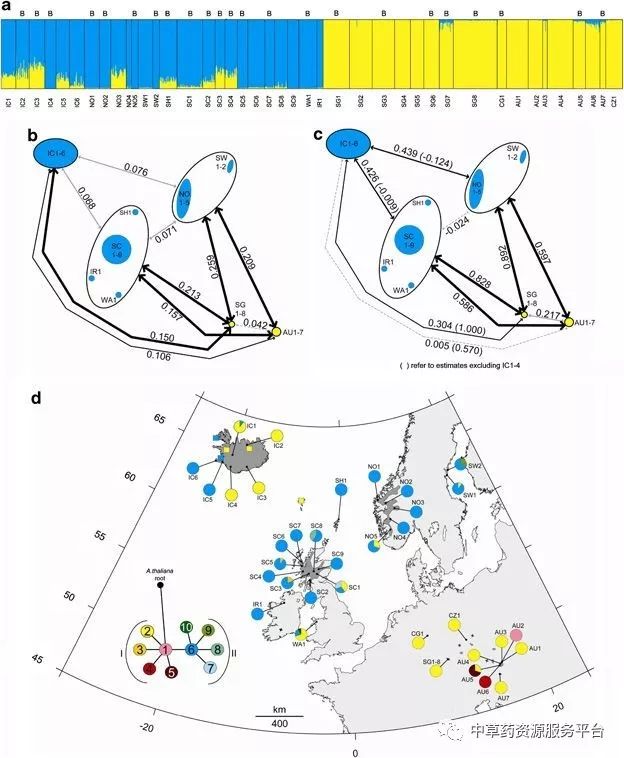杂志:Nature
volume 105, pages543–553 (2010)
摘要
了解模型生物的自然历史对于有效利用其基因组资源非常重要。琴叶拟南芥已成为用于研究的生态和进化遗传学的重要植物,基于其广泛的自然变异,基因组测序和拟南芥的密切关系。我们研究了泛欧洲拟南芥物种的遗传多样性,以探讨居群历史如何影响居群结构。我们使用核和叶绿体基因组标记物,从每个区域采样了多个种群,并结合了种群遗传和系统地理学方法。居群内部多样性对于核同工酶标记是重要的(平均P = 0.610,A e = 1.580,H e = 0.277),并且在居群之间有明显的分配(F ST = 0.271)。北部居群的近亲繁殖略有增加(F IS = 0.163与F IS= 0.093),但保留了与中欧居群的多样性。瓶颈在中欧和北欧居群中很普遍,这表明最近的居群统计学史是构成欧洲多样性的主要因素。尽管在所有地理尺度上都检测到了遗传结构,但通过贝叶斯分析确定了覆盖北欧和中欧地区的两个明显的分化单位(F CT = 0.155),并得到了区域成对F CT计算的支持。从叶绿体单倍型的分布观察到高度相似的地理模式,而中欧则没有主要的北部单倍型。我们得出结论:一A. l. petraea's属耐寒性和对生境的偏爱使欧洲中部的高山和北欧冰川与其他隐蔽避难所之间的冰川得以生存。尽管德国居群可能是冰川周围的遗留物,但奥地利东部居群的多样性却可能与长期生存相适应。

原文标题、作者、摘要
Population structure andhistorical biogeography of European Arabidopsis lyrata
S W Ansell, H K Sten?ien,M Grundmann, H Schneider, A Hemp, N Bauer, S J Russell & J C Vogel
Heredity volume 105,pages543–553 (2010)
Abstract
Understanding the naturalhistory of model organisms is important for the effective use of their genomicresourses. Arabidopsis lyrata has emerged as a useful plant for studyingecological and evolutionary genetics, based on its extensive natural variation,sequenced genome and close relationship to A. thaliana. We studied geneticdiversity across the entire range of European Arabidopsis lyrata ssp. petraea,in order to explore how population history has influenced population structure.We sampled multiple populations from each region, using nuclear and chloroplastgenome markers, and combined population genetic and phylogeographic approaches.Within-population diversity is substantial for nuclear allozyme markers (meanP=0.610, Ae=1.580, He=0.277) and significantly partitioned among populations(FST=0.271). The Northern populations have modestly increased inbreeding(FIS=0.163 verses FIS=0.093), but retain comparable diversity to centralEuropean populations. Bottlenecks are common among central and northern Europepopulations, indicating recent demographic history as a dominant factor instructuring the European diversity. Although the genetic structure was detectedat all geographic scales, two clear differentiated units covering northern andcentral European areas (FCT =0.155) were identified by Bayesian analysis andsupported by regional pairwise FCT calculations. A highly similar geographicpattern was observed from the distribution of chloroplast haplotypes, with thedominant northern haplotypes absent from central Europe. We conclude A. l.petraea's cold-tolerance and preference for disturbed habitats enabled glacialsurvival between the alpine and Nordic glaciers in central Europe and anadditional cryptic refugium. While German populations are probable peri-glacialleftovers, Eastern Austrian populations have diversity patterns possiblycompatible with longer-term survival.
解读人:黄林芳